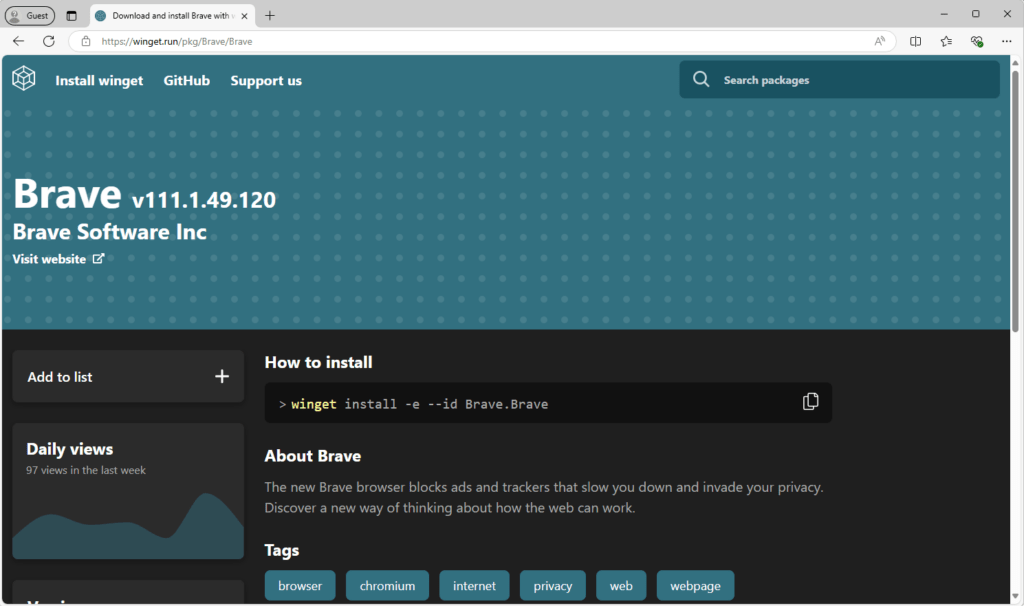Imagine you walk into a library filled with thousands of books. In a catalogue, each book has an entry, complete with a summary and a few example pages to help you decide. When you choose a book, you don’t have to search the shelves yourself— you can either order it via the catalogue and it gets delivered to you automatically, or you simply ask the librarian, who will retrieve the book and place it on your table, ready for you to read.
This is essentially how application management works in Windows with Microsoft Store and Winget. Instead of manually searching for software, downloading, and installing it, these tools act as your personal librarian, handling everything seamlessly.
In the example of the Library, Microsoft Store is the Catalogue which shows you what’s available and directly downloads and installs it, while winget is your Librarian who can assist you, even when the Catalogue is not available, but whom you need to tell exactly what you need. Otherwise, it will not be certain what you actually want …
Winget: The Command-Line Package Manager
Winget is a command-line tool that simplifies installing, upgrading, and managing applications on Windows. Think of it as a powerful way to request software from a vast catalogue (where the catalogue is a bit of a secret 😉 ), just like ordering a book from a library.
Where is Winget Located?
Winget is installed as part of App Installer, and its executable is typically found at the following location (* is for different version numbers):
C:\Program Files\WindowsApps\Microsoft.DesktopAppInstaller_*\winget.exeWhen trying to access this path, you will quite soon find out that accessing this path and viewing its content isn’t as easy as other folders in “C:\Program Files\“. This is due to a certain security feature: the Folder “C:\Program Files\WindowsApps\” is owned by TrustedInstaller and blocks access to everyone, even Administrator accounts.
But even though this is where winget.exe is located, every user profile has its own executable file in %localAppData%\Microsoft\WindowsApps\winget.exe, which is actually just a hard-link to the exe-file of the latest DesktopAppInstaller Version installed in C:\Program Files\WindowsApps\
Now, here comes one of the great features of using hard-links to the actual Executable: in a managed Environment (e.g. Company), you can simply decide if users may be able to install apps by keeping or deleting the user’s winget.exe without the need of any rules or removing it completely from the system
You can verify its presence by prompting for the current version as well as the location of the user-specific winget.exe-file:
winget --version
where wingetSources: Where Does Winget Get Apps From?
Winget pulls applications from different repositories (or “sources”), including:
- Microsoft Store – Official apps published on the Microsoft Store.
- Winget Community Repository – A curated list of third-party applications.
- Private Repositories – Organizations can set up internal sources.
To view available sources, run:
winget source listSearching for an App
winget search vscodeThis looks for Visual Studio Code and shows available versions.

Installing an App
winget install -e --id Microsoft.VisualStudioCode
The -e flag ensures an exact match on the app ID.
This will install Microsoft Visual Studio Code, commonly as a UserOnly installation, which means that the software is only available for the user who has executed the winget-command.
If you wish to explicitly install it user or machine-wide, you can use the –scope flag with 2 possible options:
--scope user: Installs Software for the Current user only--scope machine: install a Software Machine wide so every user can use it. This will explicitly prompt for Administrative Conformation
winget install -e --id Microsoft.VisualStudioCode --scope machineMost packages request that you agree to their terms. While you should always read the terms before agreeing to them, in some scenarios, it may be inconvenient to be prompted for user input. For those occasions, Winget provides the flag --accept-package-agreements to make automated Scripts run smoothly and avoid interruption:
winget install -e --id Microsoft.VisualStudioCode --accept-package-agreementsWhat if you cannot find the App?
Sometimes, you may want to install an app but don’t know its exact name or winget ID. Fortunately, there are alternative ways to find the correct identifier before running the installation command.
1. Using Winget.run
Winget.run is a community-driven website that allows you to search for applications available in the Winget repository.
Steps to find an app ID using Winget.run:
- Visit winget.run.
- Use the search bar to look for the application and select on one of the Results.
- Copy the provided winget install command and run it in PowerShell or Command Prompt.



2. Using the Microsoft Store Web
If the application is available on the Microsoft Store, you can extract its App ID directly from the store’s web link.
Steps to extract the App ID from the Microsoft Store:
- Go to the Microsoft Store website.
- Search for the app you want to install.
- Click on the app to open its details page.
- Look at the URL in your browser’s address bar—it will contain a unique App ID at the end.
For example, for Brave Browser, the Microsoft Store URL is:
https://apps.microsoft.com/detail/xp8c9qzms2pc1t?hl=en-us&gl=US
Here, xp8c9qzms2pc1t is the App ID. You can now install it using:
winget install xp8c9qzms2pc1t

Additional Winget – Commands:
Updating Apps
winget upgrade --allThis updates all installed apps that have newer versions available.
Uninstalling an App
winget uninstall -e --id Microsoft.VisualStudioCodeThis removes the application completely.
AppxPackages: Windows’ Built-in App Format
Apart from traditional installers, Windows uses AppxPackages (.appx and .msix files) for modern applications. These packages are used by Microsoft Store apps and come with built-in security, sandboxing, and seamless updates.
Why Use AppxPackages?
- Security – Apps run in a controlled environment, reducing risks.
- Easy Updates – Updates are handled automatically by the system.
- Reliability – No messy registry changes or system modifications.
Managing AppxPackages via PowerShell
Windows provides commands to list, install, and remove AppxPackages.
List Installed Packages
Get-AppxPackage
This lists all installed AppxPackages along with their details.
Install an AppxPackage
If you have an .appx or .msixbundle file, install it using:
Add-AppxPackage -Path "C:\Path\To\App.appx"
Uninstall an AppxPackage
To remove a specific AppxPackage, use:
Remove-AppxPackage -Package "Microsoft.Todos_2.0.0.0_x64__8wekyb3d8bbwe"
To list and remove a specific app by name:
Get-AppxPackage -Name "Microsoft.Todos" | Remove-AppxPackage
Re-register an AppxPackage
Sometimes, an app might not work correctly due to missing files or corruption. In such cases, re-registering the app can help.
To re-register all AppxPackages for the current user:
Get-AppxPackage | Foreach-Object {Add-AppxPackage -DisableDevelopmentMode -Register "$($_.InstallLocation)\AppxManifest.xml"}
To re-register a specific app, such as the Microsoft Store:
Get-AppxPackage -Name Microsoft.WindowsStore | Add-AppxPackage -DisableDevelopmentMode -Register "$($_.InstallLocation)\AppxManifest.xml"
This process restores missing or corrupted package registrations without reinstalling the app.
Conclusion: When to Use What?
- Winget is ideal for command-line users who want quick and efficient app installation and management.
- Microsoft Store is the go-to for graphical users who prefer a curated app experience.
- AppxPackages are used for modern Windows apps, especially those from the Store.
- Re-registering AppxPackages helps fix broken apps without reinstalling them.
With these tools, managing software on Windows has never been easier. Whether you’re a developer, IT admin, or everyday user, mastering these commands will streamline your workflow and keep your system up to date.
If you still want to know more about Package-Managíng, I suggest a look at the Microsoft Learn Documentation of the Windows-Package-Manager:
https://learn.microsoft.com/en-us/windows/package-manager/

Leave a Reply